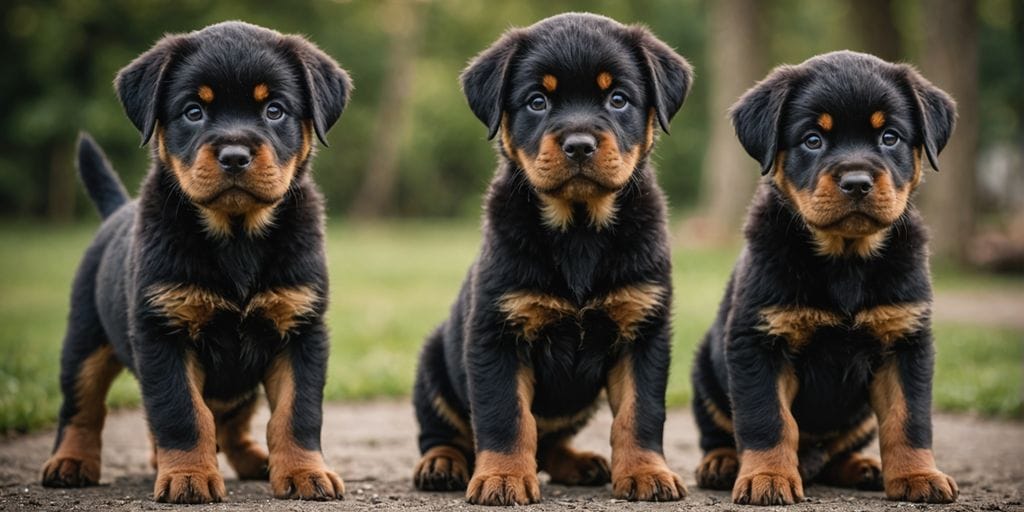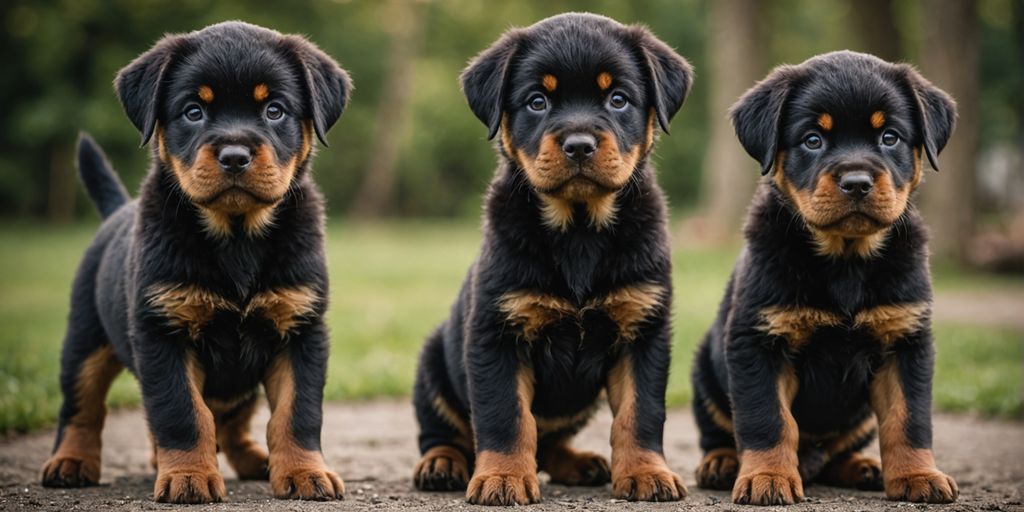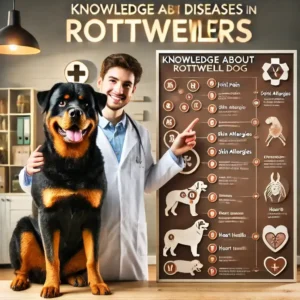Introduction
A Comprehensive Growth Chart Guide for Rottweiler. Understanding and managing your Rottweiler’s growth is paramount for ensuring a healthy and well-balanced development. Tailoring the nutritional needs at different growth stages is crucial for supporting their growing bodies. Rottweilers, as a breed, exhibit distinctive growth patterns that demand careful attention from owners and breed enthusiasts alike. These dogs are known to have been relatively fast growers during their early months, showcasing rapid increases in size and weight. This article delves into the key stages of a Rottweiler’s development, shedding light on the significance of proper nutrition, exercise, and healthcare to ensure these magnificent companions thrive throughout their lifespan.
Key Takeaways
- Rottweilers experience rapid growth in their early months, reaching about half their adult size quickly.
- Proper nutrition tailored to each growth stage is crucial for the healthy development of Rottweilers.
- Controlled and age-appropriate exercise helps prevent joint problems, which are common in large breeds like Rottweilers.
- Regular veterinary check-ups are essential for monitoring growth and addressing potential health issues early.
- Understanding gender-specific growth patterns enables owners to provide tailored care and support for their Rottweilers.
Key Stages of Rottweiler Development
Rottweilers, known for their strength and loyalty, go through several distinct stages of development. Each stage is crucial for their physical and behavioral growth, requiring specific attention to nutrition, exercise, and healthcare.
Neonatal Stage
In the first two weeks, Rottweiler puppies are in the neonatal stage. During this period, they are completely reliant on their mother for sustenance. Their eyes and ears are sealed shut, and their primary focus is on gaining weight.
Juvenile Stage
For three months to two years, Rottweilers enter the juvenile stage. This phase is marked by a substantial physical growth spurt as they gain muscle mass and reach their full size. The heightened energy levels and playfulness during this stage underscore the need for proper training and exercise.
Adolescent Stage
As Rottweilers transition into adolescence, from one to two years, they continue to refine their physical strength, endurance, and overall stature. Mental maturity also progresses during this period, with training playing a crucial role in shaping their demeanor as they approach adulthood.
Between birth and 5-7 months, large and giant breeds will have the most rapid growth during which they reach approx. 65% of their adult height.
Nutritional Needs for Growing Rottweilers
Ensuring your Rottweiler receives the right nutrition at each stage of their growth is essential for their overall health and development. Tailoring the nutritional needs at different growth stages supports their growing bodies effectively.
Puppy Nutrition
During the early stages, a high-quality puppy formula is crucial. This formula should provide the essential nutrients needed for initial development. Opt for dog foods that contain sources of omega-3 and omega-6 fatty acids such as fish oil, flaxseed, or chicken fat. These nutrients are vital for brain development and a healthy coat.
Adult Nutrition
As your Rottweiler matures, their diet should support their size and energy levels without contributing to obesity or other health issues. Adult Rottweilers thrive on a balanced diet that includes:
- Protein: 25-30%
- Fat: 10-15%
- Carbohydrates: 40-50%
- Fiber: About 4-5%
Monitoring caloric intake is essential to prevent overfeeding and maintain a healthy weight.
Senior Nutrition
For senior Rottweilers, nutritional needs change to accommodate their aging bodies. A diet lower in calories but rich in fiber helps maintain a healthy weight and supports digestive health. Additionally, supplements like glucosamine and chondroitin can aid in joint health, which is a common concern in older dogs.
Adjusting your diet as your Rottweiler ages ensures they receive the necessary nutrients to support their health and longevity.
Exercise Requirements for Each Growth Phase
Puppy Exercise

During the puppy stage, it’s crucial to introduce your Rottweiler to regular physical activity. Make sure your Rottweiler gets at least two hours of exercise a day aside from regular potty breaks. This can include short walks, playtime, and basic training sessions. Avoid high-impact activities to protect their developing joints.
Adolescent Exercise
As your Rottweiler enters adolescence, their energy levels will peak. This is the time to increase the intensity and duration of their exercise. Incorporate activities like longer walks, running, and agility training. Be mindful of their joint health and avoid over-exertion.
Adult Exercise
Adult Rottweilers require consistent exercise to maintain their health and well-being. Aim for a balanced mix of physical and mental stimulation. Activities can include daily walks, play sessions, and advanced training exercises. Regular exercise helps prevent obesity and behavioral issues.
Regular exercise is essential for your Rottweiler’s overall health and happiness. Adjust the intensity and type of activity as they grow to ensure they remain fit and healthy.
Common Health Concerns During Growth
Observing signs of healthy growth, such as a sleek and shiny coat, consistent weight gain, and alert behavior, is essential. Conversely, owners should be vigilant for signs of unhealthy growth, such as limping, reluctance to move, or excessive lethargy, which may indicate developmental issues or underlying health concerns. Regular veterinary check-ups and open communication with a veterinarian are key to proactively managing and addressing any potential issues that may arise during the crucial growth stages.
Male Rottweiler Growth and Weight Chart
The growth journey of a male Rottweiler from puppyhood to adulthood is a remarkable transformation marked by distinct physical and behavioral changes. The puppy stage typically lasts up to a year, during which Rottweilers undergo a rapid growth spurt, gaining muscle mass and reaching a significant portion of their adult size. This phase is characterized by boundless energy, curiosity, and a need for consistent training to mold their behavior.A Comprehensive Growth Chart Guide for Rottweiler
Growth Patterns
Male Rottweilers generally reach their full height by around 18 months, but their weight might continue to increase until they are two or three years old. During this phase, males often experience a more prolonged growth period compared to females. It’s essential for owners to recognize and accommodate this extended growth period, adjusting their care and exercise routines accordingly.
Weight Milestones
Below is a general weight chart for male Rottweilers:
| Age (Months) | Weight (Pounds) |
|---|---|
| 3 | 30-40 |
| 6 | 65-85 |
| 9 | 90-110 |
| 12 | 95-125 |
| 18 | 95-135 |
Fully grown males typically weigh between 95-135 pounds and stand 24-27 inches tall.
Nutritional Needs
As male Rottweilers grow, their nutritional needs change. During the puppy stage, they require a diet rich in protein and fat to support their rapid growth. As they transition into adulthood, their diet should be adjusted to maintain a healthy weight and support their energy levels. Senior Rottweilers may need a diet lower in calories but are rich in joint-supporting nutrients to ensure their overall well-being.
Understanding the breed’s growth patterns, including gender-specific variations, empowers owners to provide tailored care and support at each stage of their Rottweiler development.
Female Rottweiler Growth and Weight Chart
Female Rottweilers undergo a growth journey with distinct patterns, similar yet subtly different from their male counterparts. Understanding these patterns helps in providing tailored care and support at each stage of their development.
Monitoring Your Rottweiler’s Growth
Understanding and monitoring your Rottweiler growth pattern is crucial for ensuring a healthy and fulfilling life for your canine companion. A comprehensive knowledge of the different growth stages, nutritional needs, and exercise requirements enables owners to provide tailored care, addressing the specific demands of each developmental phase. A Comprehensive Growth Chart Guide for Rottweiler Recognizing the breed’s tendencies, such as the slightly prolonged growth period in males and the impact of the heat cycle on females, empowers owners to navigate their Rottweiler’s growth journey with insight and attentiveness. Regular veterinary check-ups are essential for the proactive management of your Rottweiler’s health, allowing for early detection of potential issues and ensuring effective care. Prevention and early detection are key in managing health issues related to growth in Rottweilers. Owners should closely monitor their Rottweiler’s gait, mobility, and signs of discomfort as indicators of joint problems or other growth-related concerns. Maintaining a controlled and well-balanced diet that meets the nutritional needs of Rottweilers at different growth stages is vital for their overall well-being.
Conclusion
In conclusion, understanding and monitoring your Rottweiler’s growth pattern is paramount for ensuring a healthy and fulfilling life for your canine companion. A comprehensive knowledge of the different growth stages, nutritional needs, and exercise requirements enables owners to provide tailored care, addressing the specific demands of each developmental phase. By being attentive to these aspects, you can help your Rottweiler thrive, ensuring they grow into strong, healthy, and well-balanced adults. Remember, a well-informed owner is the key to a happy and healthy Rottweiler.
The key stages of Rottweiler development include the Neonatal Stage, Juvenile Stage, and Adolescent Stage. Each stage is characterized by specific physical and behavioral changes.
Rottweilers have different nutritional needs at various growth stages. Puppies require a high-quality puppy formula with essential nutrients, while adult Rottweilers need a balanced diet with appropriate protein, vitamins, and minerals. Senior Rottweilers may need a diet tailored to their reduced activity levels and potential health concerns.
Puppies need controlled and gentle exercise to prevent joint issues. Adolescents require more structured and consistent exercise to manage their energy levels and support muscle development. Adult Rottweilers benefit from regular and varied exercise to maintain their strength and overall health.
Common health concerns for growing Rottweilers include joint problems, nutritional deficiencies, and behavioral issues. Regular vet check-ups and a balanced diet can help mitigate these concerns.
Male Rottweilers tend to have a more prolonged growth period in terms of height and weight compared to females. Understanding these gender-specific growth patterns helps in providing tailored care and support.
Monitoring your Rottweiler’s growth involves regular vet check-ups, tracking their weight and height, and adjusting their diet and exercise as needed. Keeping a growth chart can be helpful in ensuring they are developing healthily.











